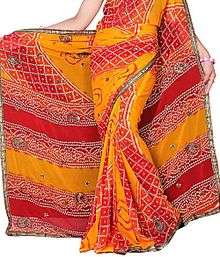Bandhani
Bandhani (Hindi: बांधानी) is a type of tie-dye textile decorated by plucking the cloth with the fingernails into many tiny bindings that form a figurative design.[1] The term bandhani is derived from the Sanskrit verbal root bandh ("to bind, to tie").[2][3] Today, most Bandhani making centers are situated in Gujarat,[4] Rajasthan,[1] Sindh, Punjab region[5] and in Tamil Nadu where it is known as Sungudi.[6][7] Earliest evidence of Bandhani dates back to Indus Valley Civilization where dyeing was done as early as 4000 B.C. The earliest example of the most pervasive type of Bandhani dots can be seen in the 6th century paintings depicting the life of Buddha found on the wall of Cave 1 at Ajanta.[8] Bandhani is also known as Bandhej Saree, Bandhni, Piliya, and Chungidi in Tamil and regional dialects. Other tying techniques include Mothra, Ekdali and Shikari depending on the manner in which the cloth is tied. The final products are known with various names including Khombi, Ghar Chola, Patori and Chandrokhani
Overview

.jpg)
.jpg)
The art of Bandhani is a highly skilled process. The technique involves dyeing a fabric which is tied tightly with a thread at several points, thus producing a variety of patterns like Chandrakala, Bavan Baug, Shikari etcetera; depending on the manner in which the cloth is tied. The main colour used in Bandhana are yellow, red, blue, green and black.
The main colours used in Bandhana are natural. As Bandhani is a tie and dye process, dying is done by hand and hence best colours and combinations are possible in Bandhanis.
The Bandhani work has been exclusively carried out by the Khatri community of Kutchh and Saurashtra. A meter length of cloth can have thousands of tiny knots known as 'Bheendi' in the local language ('Gujarati'). These knots form a design once opened after dyeing in bright colours. Traditionally, the final products can be classified into 'khombhi', 'Ghar Chola', 'Chandrakhani', 'Shikari', 'Chowkidaar', 'Ambadaal' and other categories.
kutch in India is known for Bandhanis. Bandhani work is also done in Rajasthan state but having different types of colours and designs than the Kutch and Saurashtra of Gujarat. Establishments of varying sizes in the entire Kutch belt in Gujarat produce many varieties of Bandhani. This Bandhani style is called as the Kutchi Bandhani, which is also practised in the Saurashtra
region of Gujarat. Bandhani tying is often a family trade, and the women of these families work at home to tie patterns. Pethapur, Mandavi, Bhuj, Anjar, Jetpur, Jamnagar, Rajkot, are some of the main towns in Gujarat, where Bandhani is created. The city of Bhuj, located in the Gulf of Kutch, in Gujarat is well known for its red Bandhani. Dyeing process of Bandhani is carried out extensively in this city, as the water of this area is known to give a particular brightness to colors, specifically reds and maroons.
In Bandhani, different colours convey different meanings. People believe that wearing Red brings good luck to a newly wed's life.
History
Earliest evidence of Bandhani dates back to Indus Valley Civilization suggest that dyeing was done as early as 4000 B.C. The earliest example of the most pervasive type of Bandhani dots can be seen in the 6th century paintings depicting the life of Buddha found on the wall of Cave I at Ajanta.[9] This art finds its mentions in the Alexander the great time texts about the beautiful printed cottons of India. As per evidences in Historical Texts, the first Bandhani saree was worn at the time of Bana Bhatt`s Harshacharita in a royal marriage. It was believed that wearing a Bandhani saree can bring good future to a bride. Ajanta walls stand for the evidences of these Bandhani sarees. The dyers have experimented with the use of different elements both natural and man-made for ages. Also, there are experiments with different binding/tying techniques to create patterns on cloth immersed in containers of dye. Different types of tie and dyes have been practiced in India.
Bandhej Saree

Bandhej saree which is also known as "Bandhani saree" is specially found in Gujarat and Rajasthan. The name bandhani means tying up, as it is taken by Hindi pronoun ‘bandhan’. As per the region of manufacturing the patterns of Bandhej Saree may vary. The fine variety of this type of saree is created in Pethapur, Mandvi, Bhuj, Anjar, Jamnagar, Jetpur, Porbandar, Rajkot, Udaipur, Jaipur, Ajmer, Bikaner etc.
These types of sarees are getting more popular as they can be worn on any occasion.
Gallery
.jpg) Bandhani sari
Bandhani sari.jpg) Bandhani
Bandhani- Bandhani sari
.jpg) Bandhani Dupatta
Bandhani Dupatta.jpg) Bandhani Dupatta
Bandhani Dupatta Preparing bandhani craft
Preparing bandhani craft.jpg) Rajasthani bandhani pagri
Rajasthani bandhani pagri
References
| Wikimedia Commons has media related to Bandhani. |
- G. K. Ghosh, Shukla Ghosh (January 1, 2000). "3". Ikat Textiles of India. APH Publishing (published 2000). ISBN 978-8170247067. Retrieved March 28, 2017.
- Monier-Williams Sanskrit-English Dictionary 1899. Wada, Yoshiko Iwamoto (2002). Memory on Cloth: Shibori Now. Kodansha International. p. 28. ISBN 9784770027771.
- Gujarat State Gazetteers: Junagadh (1971)
- Brenda M. King (September 3, 2005). Silk and Empire. Manchester University Press (published 2005). p. 59. ISBN 978-0719067013. Retrieved March 19, 2017.
- Feliccia Yacopino (1977) Threadlines Pakistan
- Nasreen Askari, Liz Arthur, Paisley Museum and Art Galleries Merrell Holberton, (1999) Uncut cloth
- Wada, Yoshiko Iwamoto (2002). Memory on Cloth: Shibori Now. Kodansha International. p. 28. ISBN 9784770027771.
- Wada, Yoshiko Iwamoto (2002). Memory on Cloth: Shibori Now. Kodansha International. p. 28. ISBN 9784770027771.
- Wada, Yoshiko Iwamoto (2002). Memory on Cloth: Shibori Now. Kodansha International. p. 28. ISBN 9784770027771.